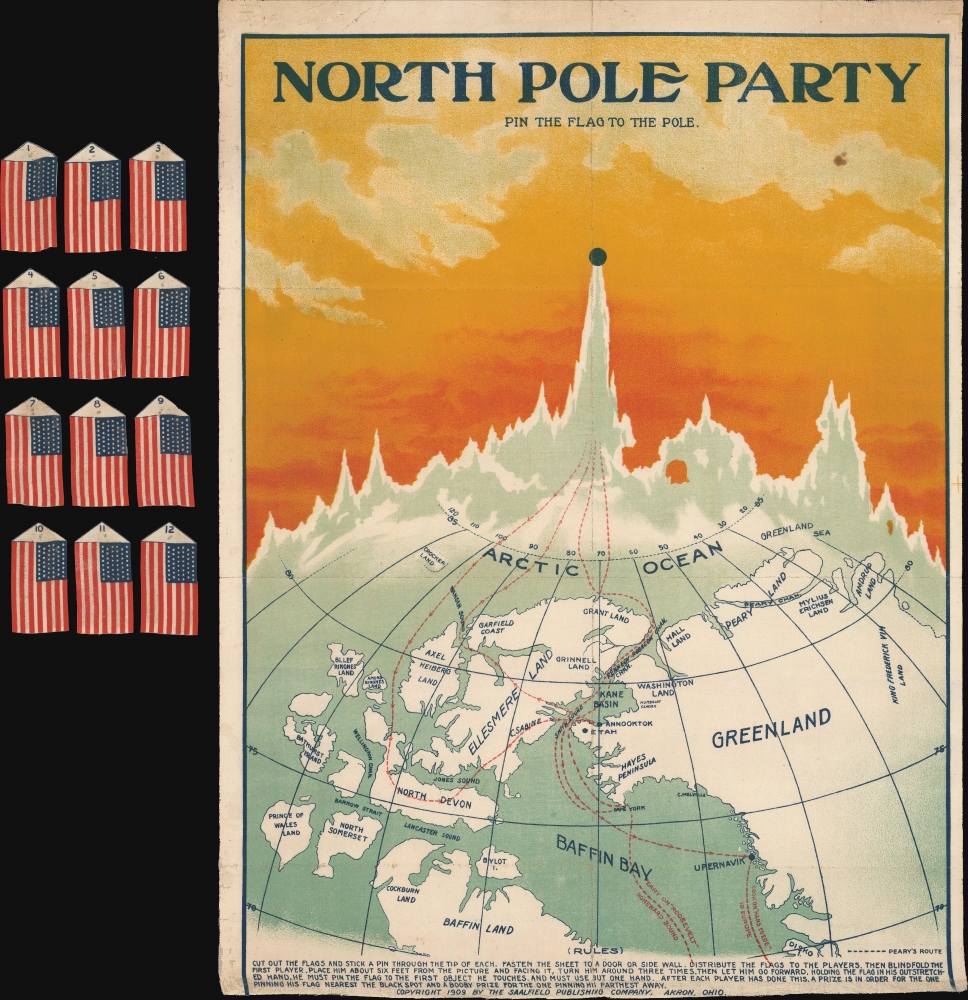Digital Image: 1909 Pictorial View and Game of the North Pole, Peary Expedition
NorthPoleParty-saalfield-1909_d
Title
1909 (dated) 24 x 18 in (60.96 x 45.72 cm)
Description
FOR THE ORIGINAL ANTIQUE MAP, WITH HISTORICAL ANALYSIS, CLICK HERE.
Digital Map Information
Geographicus maintains an archive of high-resolution rare map scans. We scan our maps at 300 DPI or higher, with newer images being 600 DPI, (either TIFF or JPEG, depending on when the scan was done) which is most cases in suitable for enlargement and printing.
Delivery
Once you purchase our digital scan service, you will receive a download link via email - usually within seconds. Digital orders are delivered as ZIP files, an industry standard file compression protocol that any computer should be able to unpack. Some of our files are very large, and can take some time to download. Most files are saved into your computer's 'Downloads' folder. All delivery is electronic. No physical product is shipped.
Credit and Scope of Use
You can use your digial image any way you want! Our digital images are unrestricted by copyright and can be used, modified, and published freely. The textual description that accompanies the original antique map is not included in the sale of digital images and remains protected by copyright. That said, we put significant care and effort into scanning and editing these maps, and we’d appreciate a credit when possible. Should you wish to credit us, please use the following credit line:
Courtesy of Geographicus Rare Antique Maps (https://www.geographicus.com).
How Large Can I Print?
In general, at 300 DPI, you should at least be able to double the size of the actual image, more so with our 600 DPI images. So, if the original was 10 x 12 inches, you can print at 20 x 24 inches, without quality loss. If your display requirements can accommodate some loss in image quality, you can make it even larger. That being said, no quality of scan will allow you to blow up at 10 x 12 inch map to wall size without significant quality loss. For more information, it is best consult a printer or reprographics specialist.
Refunds
If the high resolution image you ordered is unavailable, we will fully refund your purchase. Otherwise, digital images scans are a service, not a tangible product, and cannot be returned or refunded once the download link is used.
Cartographer
Arthur J. Saalfield (April 1863 - January 11, 1919) founded the Saalfield Publishing Co. (1900 - 1977), a major publisher of children's books and other materials, including dictionaries and encyclopedias, based in Akron, Ohio. Born in Leeds, England, Saalfield and his family moved to the United States when he was a young boy. Settling first in New York City, Saalfield's father died shortly afterwards, and the family moved to Chicago. Arthur began working in the book trade at the age of nine, then moved to New York as a teenager to attend school, but quickly fell back into the book trade. He developed a reputation as a very effective salesman and quickly rose in the ranks of the industry. In 1892, he started his own bookselling business but left it in 1898 to run the trade book division of the Werner Company (founded in 1884 by Paul E. Werner, 1850-1931), based in Akron. Soon afterwards, Saalfield bought out the division from Werner; thus, the Saalfield Publishing Co. was a successor to Werner Company, though Werner continued to publish educational books afterwards occasionally. Werner's operation was already sizeable when Saalfield purchased it, and the latter wasted no time in ramping up production even further, moving several times to larger premises and churning out encyclopedias, novels (by the likes of Mark Twain, Horatio Alger, and Louisa May Alcott), and illustrated books of fairy tales. At its height, the company was one of the world's largest and most prominent publishers of children's books and games. Like many contemporary publishers, the company was bogged down in copyright litigation in the early 20th century, particularly with the Encyclopedia Britannica . Saalfield also began to experience health problems and was convalescing in Florida when he died in 1919. In 1885, he married the children's book author Adah Louise Sutton (1860 - 1935), and the couple had five children together. The eldest, Albert G. Saalfield (1886 - 1959), had worked with his father for several years and inherited management of the business. The Saalfield Publishing Co. continued to operate until 1977, after which its records were turned over to Kent State University. In 1987, the former company's large building in Akron burned down in a massive fire. More by this mapmaker...

